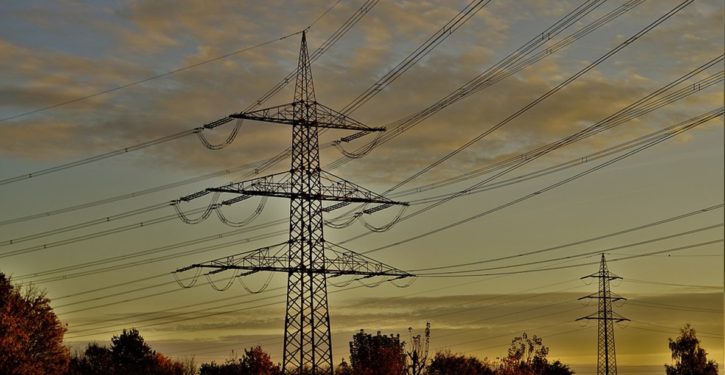
“Costly and counterproductive energy restrictions introduced by the Biden administration” are likely to cause blackouts in the future, says the National Review:
In May, the Environmental Protection Agency (EPA) announced proposed rules to regulate carbon dioxide emissions from new and existing power plants….modeling at American Experiment found these strict regulations would cause massive rolling blackouts in America’s heartland by forcing reliable, abundant forms of traditional U.S. energy — like coal and natural gas — out of use.
On top of blackouts, these regulations will also result in higher power bills and greater dependence on hostile foreign energy sources…
In two recent congressional hearings, the House Committee on Science and Technology and House Committee on Energy and Commerce zeroed in on the harmful impacts that the new rules will have on America’s energy security and reliable electricity…The hearings shed light on the vulnerability of our nation’s electric grid and how the proposed rules will further strain an increasingly unstable system.
Congressman Brian Babin (R., Texas), questioning EPA administrator Michael Regan, cited utility providers’ warnings that “this rule will only serve to cost hundreds of billions of dollars, significantly raise customers’ power bills, and require a rapid transition away from reliable American-produced natural gas without a realistic plan to fully replace that generation.”
Without reliable coal and natural-gas power plants, Americans will experience more frequent rolling blackouts and brownouts nationwide.
An analysis by the North American Electric Reliability Corporation found that around two-thirds of North America was at risk of energy shortfalls during periods of “extreme demand” this summer. While the U.S. avoided major outages in the summer of 2023, scheduled coal-plant closures in response to EPA regulations and energy policies enacted in liberal states will reduce our margin for error moving forward, which is why the North American Electric Reliability Corporation, the entity responsible for establishing and enforcing reliability standards in the U.S., identified energy policy as a major risk to grid reliability in its August 2023 report.
The threat is not lost on the American people. Nearly 70 percent of Americans are concerned about power plants retiring without enough replacement energy to meet demand.
In the Energy and Commerce Committee hearing, Congressman Larry Bucshon (R., Ind.) quoted four of the nation’s largest grid operators…warning that the carbon rules “have the potential to materially and adversely impact electrical reliability” and “when combined with other EPA rules and other policy actions, could well exacerbate the disturbing trend and growing risk” to grid reliability…
As the administration forces the country into more weather-dependent energy sources, like wind and solar, it is not just compromising the reliability of the nation’s electricity supply, it is also compromising our national security.
There is no bigger beneficiary of the current direction of climate policy than America’s adversaries such as China and Russia. Not only does America’s current energy policy strengthen Russia’s geopolitical hand as global energy supplier, but it also makes our economy even more dependent on the rare-earth elements and raw materials found in wind turbines, solar panels, and electric vehicles, most of which are produced or processed in China.
Other things also endanger the power grid, notes David Strom: “There is a serious and growing shortage of spare transformers… supply chain issues have extended the time from ordering a transformer to its delivery from a few weeks to as much as a year.” As Transformers Magazine notes,
Power companies have issued warnings about dangerous transformer shortages in the USA.
US power companies are raising the alarm about a potential energy crisis. Transformers are crucial to the grid because they change the voltage of electricity to make it usable. However, energy trade groups warn that the nation can’t count on aging transformers to keep the power on. Also, if transformers blow during storms, it could take more than a year for power companies to get new ones due to the supply chain shortage. ERMCO estimates that, in case a storm blows enough transformers in a city with no reserves, it could take several weeks to bring the lights back on.
Mike Partin, president and CEO of the Sequatchie Valley Electric Cooperative, says there is a supply chain problem putting USA at risk because it could take 52 to 56 weeks to get new transformers instead of the typical 4-week turnaround from manufacturers.
As old power plants close, America’s power grid has become increasingly unreliable, according the Wall Street Journal. The U.S. faces the risk of of blackouts in the summer and during winter cold waves. Yet, President Biden has called for getting rid of coal plants, saying, “We’re going to be shutting these plants down all across America.” That could cause blackouts that kill hundreds or even thousands of people, as energy runs short. Blackouts already killed 200 people in 2021, as freezing people were left without power.
“Large swaths of North America may face blackouts and other energy emergencies during bouts of extreme cold,” reported Bloomberg News last year. “Severe weather may stress grids by causing demand to soar while supplies of natural gas, coal and back-up fuel oil are all tight, leaving little room for error.”
Yet, on November 4, President Biden called for getting rid of coal plants, saying, “We’re going to be shutting these plants down all across America.” That could cause blackouts that kill hundreds of people. Blackouts already killed 200 people in 2021, as freezing people were left without power. Yet, “there are 40 coal-fired power plants scheduled to be taken offline in the name of fighting climate change. No replacement sources for all of that juice have been proposed, to say nothing of having them come online,” notes Hot Air.
Biden has suggested that we could just use “wind and solar power” when coal plants close. But that is not a solution, because wind and solar energy are at the mercy of the weather, and are growing too slowly to immediately replace coal. As the liberal Brookings Institution notes, wind and solar projects can take over a decade to complete:
Most wind energy projects in the pipeline are stuck in the permitting phase, with just 21% of planned projects currently under construction…..Each of the federal permits [required] may take months or years to be approved. … The dizzying array of permits and other regulatory obstacles to renewable energy projects can create extremely long delays. Reports of 10-year or longer timelines for transmission lines are not uncommon, and both solar and wind projects face long permitting delays.
Moreover, as a leading German newspaper notes, “Sometimes the wind simply doesn’t blow, meaning the rotors remain idle and no power can be generated. A reliable power grid therefore requires additional forms of energy production and storage.”
As Forbes notes,
Solar and wind require that natural gas plants, hydro-electric dams, batteries or some other form of reliable power be ready at a moment’s notice to start churning out electricity when the wind stops blowing and the sun stops shining….And unreliability requires solar- and/or wind-heavy places like Germany, California, and Denmark to pay neighboring nations or states to take their solar and wind energy when they are producing too much of it.
In addition to shutting down many coal plants, progressives have also shut some nuclear plants. That is unfortunate, because it is hard to beat nuclear power, from an environmental standpoint. It produces no air pollution or greenhouse gas emissions (just harmless steam). It results in fewer deaths per unit of energy produced than virtually all other forms of energy. And unlike wind or solar power, nuclear plants produce a constant, reliable flow of electricity regardless of whether the weather changes.
As Michael Shellenberger points out, “wind turbines…kill more people than nuclear plants.” Moreover, “solar panels require 17 times more materials in the form of cement, glass, concrete, and steel than do nuclear plants, and create over 200 times more waste.” As Yale University’s Steve Novella notes, “Nuclear waste can be dealt with, and the newer reactors produce less waste, and can even theoretically burn reprocessed waste from older plants.
Yet, in August, Illinois Governor J.B. Pritzker (D) vetoed a bill that would have lifted Illinois’ moratorium on new nuclear power plants.



